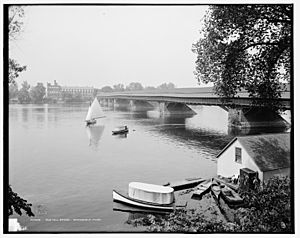Memorial Bridge (Massachusetts) facts for kids
The Hampden County Memorial Bridge (also called the Springfield Memorial Bridge) is a strong concrete bridge built in 1922. It crosses the Connecticut River and connects Springfield, Massachusetts with West Springfield, Massachusetts. This important bridge carries both cars and people, and it's part of Massachusetts Route 147. The bridge is about 209 feet (64 meters) long and stands about 30 feet (9 meters) above the river. It's owned by the Massachusetts Highway Department.
Quick facts for kids Hampden County Memorial Bridge |
|
|---|---|

Memorial Bridge
|
|
| Coordinates | 42°05′56″N 72°35′42″W / 42.09889°N 72.59500°W |
| Carries | pedestrian and vehicular traffic ( |
| Crosses | Connecticut River, Amtrak |
| Locale | Springfield, Massachusetts, to West Springfield, Massachusetts |
| Maintained by | Massachusetts Highway Department |
| Characteristics | |
| Design | reinforced-concrete arch bridge |
| Total length | 1,515 feet (462 m) |
| Width | 82.5 feet (25.1 m) |
| Longest span | 209 feet (64 m) |
| History | |
| Architect | Haven & Hoyt |
| Designer | Fay, Spofford & Thorndike |
| Engineering design by | Daniel O'Connell's Sons Adam & Buxton Constr. Co. George W. Hayden |
| Constructed by | H. P. Converse & Co., Contractors |
| Construction begin | 1920 |
| Opened | 1922, 1996 |
Building the Memorial Bridge
Before the current bridge, there was an older wooden bridge across the Connecticut River in Springfield. The very first bridge was built in 1805, but it fell down in 1814. A new covered wooden bridge was then built by Isaac Damon. This older bridge lasted for a long time, even into the 1900s. The new concrete Memorial Bridge was built to replace it.
In 1915, people started talking about building a new bridge. By 1918, they finally agreed on where the new concrete bridge would be and what it would look like. Construction began on April 3, 1920, and the bridge was finished and opened to traffic on August 3, 1922.
During the opening ceremony, the bridge was dedicated to remember "those who had died as pioneers, and soldiers in the Revolutionary, Civil and Foreign Wars." This is why it's called the Memorial Bridge. The bridge was designed by a company called Fay Spofford & Thorndike, with architects Haven & Hoyt.
How the Bridge Was Designed
The Memorial Bridge is an arch bridge made of reinforced concrete. This means it has strong concrete arches with steel bars inside to make them even stronger. It has seven main arches over the river. Each of these river arches is made of five strong concrete ribs.
The longest arches are about 209 feet (64 meters) long. The bridge also has a long concrete section that goes over the train tracks. The piers, which are the supports holding up the bridge, are made of concrete covered with granite.
The bridge once had two decorative gargoyles, which are carved stone figures, on the south side. These were removed when the bridge was updated. There are also four special plaques on the central towers. These plaques honor the first settlers and soldiers from the American Revolutionary War, the American Civil War, and World War I.
The 1922 Memorial Bridge was special because it had the longest single concrete arch span in Massachusetts at the time. Its design used a clever method to make the steel arches support themselves and the weight of the concrete during construction. This made the bridge very strong and allowed for lighter arches.
Bridge Repairs in 1996
By the 1990s, parts of the bridge's concrete were starting to wear out due to a problem called Alkali-Silica Reactivity (ASR). This meant the bridge needed major repairs.
In 1996, a big project was started to fix the bridge. The entire top part of the bridge, called the deck system, was replaced. Any decorative parts that were damaged were either replaced with new cast stone or with strong fiberglass copies. The section of the bridge that goes over the railroad tracks was also replaced with new, strong concrete beams.
This important repair project was finished in 1996 by a company called Daniel O'Connell's Sons.


